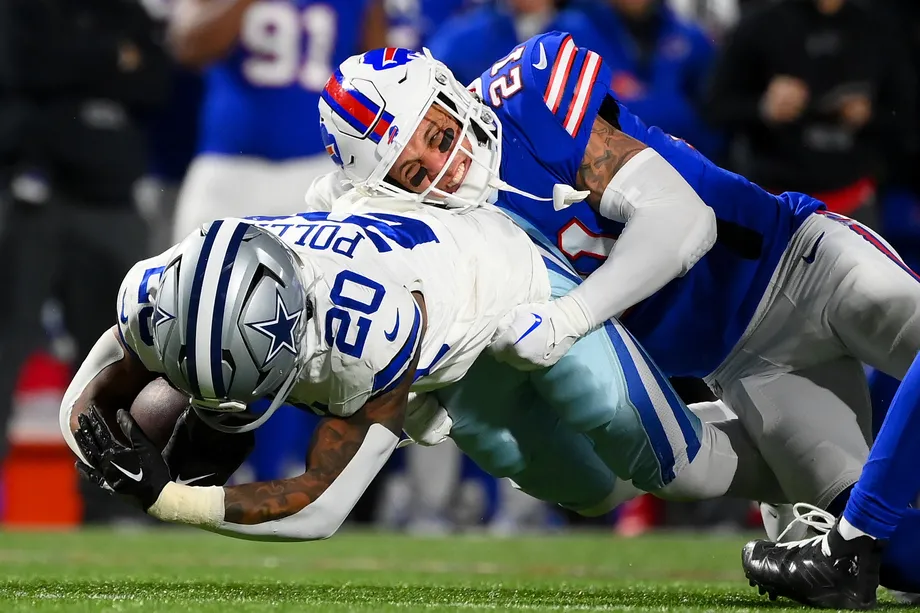2023 Cowboys analytics roundup: Dallas drops after crushing Bills’ loss
How detrimental do you think last week’s game was for the Cowboys? Well, it was quite an event. The Cowboys faced a tough match in Buffalo, where they were dominated in every aspect of the game and ended up losing 31-10, leaving many Cowboys fans lacking confidence. Amidst all the chaos, it’s worth noting that Dallas secured a playoff spot just before the game started. However, their chances of hosting at least one playoff game diminished after the defeat.
Certainly, the Cowboys have secured a playoff spot, an achievement accomplished just one game into December. Yet, the question arises: how do they compare to the top teams, and to what extent did the disheartening loss to the Bills set them back? As usual, it’s that time of the week when we rely on analytics to delve into these matters.
Cowboys Efficiency at a Glance
| DVOA | DVOA Rank | DVOA Rank Previous Rank | Weighted DVOA | Weighted DVOA Rank | |
|---|---|---|---|---|---|
| Offense | 9.4% | 9th | 6th | 12.3% | 7th |
| Defense | -6.9% | 6th | 5th | -4.5% | 9th |
| Special Teams | 2.7% | 7th | 8th | 3.4% | 6th |
| Overall | 19.0% | 6th | 4th | 20.2% | 6th |
Predictably, the Cowboys have experienced a decline in the DVOA rankings following their recent game, slipping from the fourth position to the sixth overall. Notably, there is a considerable gap between them and the two teams immediately ahead, one of which happens to be the Dolphins, the upcoming hosts for the Cowboys.
:format(webp):no_upscale()/cdn.vox-cdn.com/uploads/chorus_asset/file/25174651/download.png)
Nevertheless, the Cowboys maintain the second-best DVOA grade in the NFC, with the Lions trailing behind at the seventh spot with a significantly lower 14.2% grade. While there is a substantial difference between the 49ers and the Cowboys, there is also a notable separation between Dallas and the rest of the conference.
This trend is mirrored in the team tiers based on EPA, where the Cowboys exhibit a substantial lead over the Eagles and Lions, though there remains a notable gap with San Francisco. Overall, the Cowboys find themselves in a favorable position, yet the stark contrast between the top two NFC teams raises concerns about their playoff durability.
Interestingly, it is both intriguing and somewhat amusing that the Cowboys and the Dolphins share nearly identical total EPA/play in the week they face each other. Despite their divergent strategies and personnel, the team efficiency metrics suggest a closely contested match.
Offense
Cowboys Offensive Efficiency
| Grade | Rank | |
|---|---|---|
| Offensive DVOA | 9.4% | 9th |
| Pass DVOA | 23.9% | 10th |
| Run DVOA | -3.2% | 13th |
| EPA/Play | 0.114 | 4th |
| EPA/Dropback | 0.204 | 2nd |
| EPA/Rush | -0.037 | 9th |
The Cowboys offense had a poor game, easily their worst since the Week 5 disaster against the 49ers. Some external variables contributed, but Buffalo also played exceptionally effectively on offense, regularly removing the first and second read as their pass rush went to work.
Having said that, the offense’s efficiency ranks did not decline significantly. To be sure, they fell overall, but not dramatically. This is still a top-10 offense by nearly every metric, and there’s reason to believe they’ll get back on track this week in a much better setting.
Dak Prescott’s Efficiency
| Grade | Rank | |
|---|---|---|
| QBR | 72.7 | 2nd |
| EPA/play | 0.225 | 2nd |
| CPOE | 3.3 | 7th |
| DVOA | 18.2% | 6th |
| DYAR | 1023 | 5th |
In his inaugural match as the clear frontrunner for the MVP award, Dak Prescott delivered a subpar performance. His player grade of 39.4 from Pro Football Focus marked his lowest of the season. Prescott struggled throughout, completing only 61.8% of his passes and committing four plays deemed worthy of turnovers, including an interception. This performance contrasted sharply with his previous eight games, where he had only three turnover-worthy plays and one interception.
However, similar to the overall offensive struggles, Prescott’s off-game doesn’t overshadow his exceptional season. Despite the setback, he continues to have one of the finest quarterback seasons this year, maintaining a top-four position in MVP odds according to most sportsbooks. Although Prescott faces a challenging path to re-enter the MVP race, his performance in the remaining three weeks will significantly influence the ongoing conversation about his candidacy.
Cowboys Offensive Line Efficiency
| Grade | Rank | |
|---|---|---|
| Pressure Rate | 15.0% | 3rd |
| Adjusted Sack Rate | 7.0% | 13th |
| Blown Block Rate | 2.44% | 11th |
| Pass Block Win Rate | 57% | 18th |
| Run Block Win Rate | 72% | 5th |
| Adjusted Line Yards | 4.33 | 8th |
Surprisingly, despite Prescott being sacked three times, the Cowboys’ offensive line didn’t suffer significant setbacks in performance metrics this week. In fact, they were officially charged with only one sack and five pressures. This can be attributed to Prescott’s prolonged average time of 2.93 seconds per throw, an unusually high and unsustainable duration for any offense. This extended time to throw highlights how frequently the Bills disrupted Prescott’s initial reads, compelling him to move around more than usual.
Reinforcing this observation is the fact that the offensive line’s win rates, both in pass protection and the running game, remained consistent this week. These metrics gauge the line’s ability to maintain their blocks for 2.5 seconds, irrespective of the events that unfold beyond that timeframe. Although Prescott faced considerable pressure in the game, the offensive line generally upheld their responsibilities more often than not.
Defense
Cowboys Defensive Efficiency
| Grade | Rank | |
|---|---|---|
| Defensive DVOA | -6.9% | 6th |
| Pass Defense DVOA | -4.2% | 6th |
| Run Defense DVOA | -10.2% | 16th |
| Pass Rush Win Rate | 60% | 1st |
| Run Stop Win Rate | 29% | 29th |
| EPA/Play | -0.086 | 6th |
| EPA/Dropback Allowed | -0.080 | 6th |
| EPA/Rush Allowed | -0.097 | 13th |
We’ve reached the defensive segment of the analytics roundup, where the critique intensifies this week. Describing the Cowboys’ defensive performance as putrid would be an understatement. Their run defense suffered a significant blow, getting exploited to a staggering extent. The impact was so substantial that they plummeted from sixth to 16th in run defense DVOA in just one week. Reflecting on this, consider the rarity of such a drastic shift.
DVOA grades are expressed as percentages, taking the entire dataset into account. Typically, with more data, DVOA grades exhibit less volatility from week to week. For the Cowboys to experience a 10-spot drop in a single week, despite 15 weeks of data contributing to the grade calculation, indicates a historically disastrous game of epic proportions for their run defense.
Cowboys Pass Coverage
| letions | Completion Rate | Passer Rating Allowed | ADOT When Targeted | Air Yards Allowed | Yards After Catch | ||
|---|---|---|---|---|---|---|---|
| Trevon Diggs | 8 | 2 | 25.0% | 1.0 | 15.9 | 6 | 20 |
| Stephon Gilmore | 74 | 40 | 54.1% | 83.2 | 10.9 | 341 | 179 |
| DaRon Bland | 76 | 41 | 53.9% | 49.9 | 11.6 | 346 | 189 |
| Jourdan Lewis | 54 | 38 | 70.4% | 115.1 | 8.4 | 269 | 196 |
| Jayron Kearse | 30 | 24 | 80.0% | 89.2 | 7.9 | 166 | 96 |
| Malik Hooker | 10 | 8 | 80.0% | 118.8 | 9.8 | 76 | 84 |
| Donovan Wilson | 19 | 15 | 78.9% | 129.8 | 4.8 | 36 | 92 |
| Juanyeh Thomas | 12 | 7 | 58.3% | 98.3 | 3.3 | 5 | 52 |
| Leighton Vander Esch | 7 | 5 | 71.4% | 87.2 | 0.4 | -1 | 44 |
| Markquese Bell | 36 | 26 | 72.2% | 90.2 | 1.1 | 4 | 237 |
| Damone Clark | 26 | 21 | 80.8% | 102.7 | 1.4 | 7 | 138 |
Surprisingly, the pass defense displayed a satisfactory performance in this game. Admittedly, this can be attributed to the fact that Josh Allen threw only 15 passes throughout the entire game. Nevertheless, Dallas performed well when Allen did decide to throw. The absence of Malik Hooker raised concerns about the defense’s capability to prevent deep shots, a staple of the opposing offense. However, Allen attempted just one pass over 20 yards downfield, which unfortunately ended in an incomplete pass.
The only defensive player who encountered difficulties in coverage during this week was Damone Clark, although this observation is based on a limited set of instances. Clark’s singular target occurred in the red zone against James Cook, resulting in a touchdown for Cook. It’s challenging to draw significant conclusions about the secondary’s performance from this particular game, but the upcoming challenge against the Dolphins is likely to provide a more comprehensive test.

